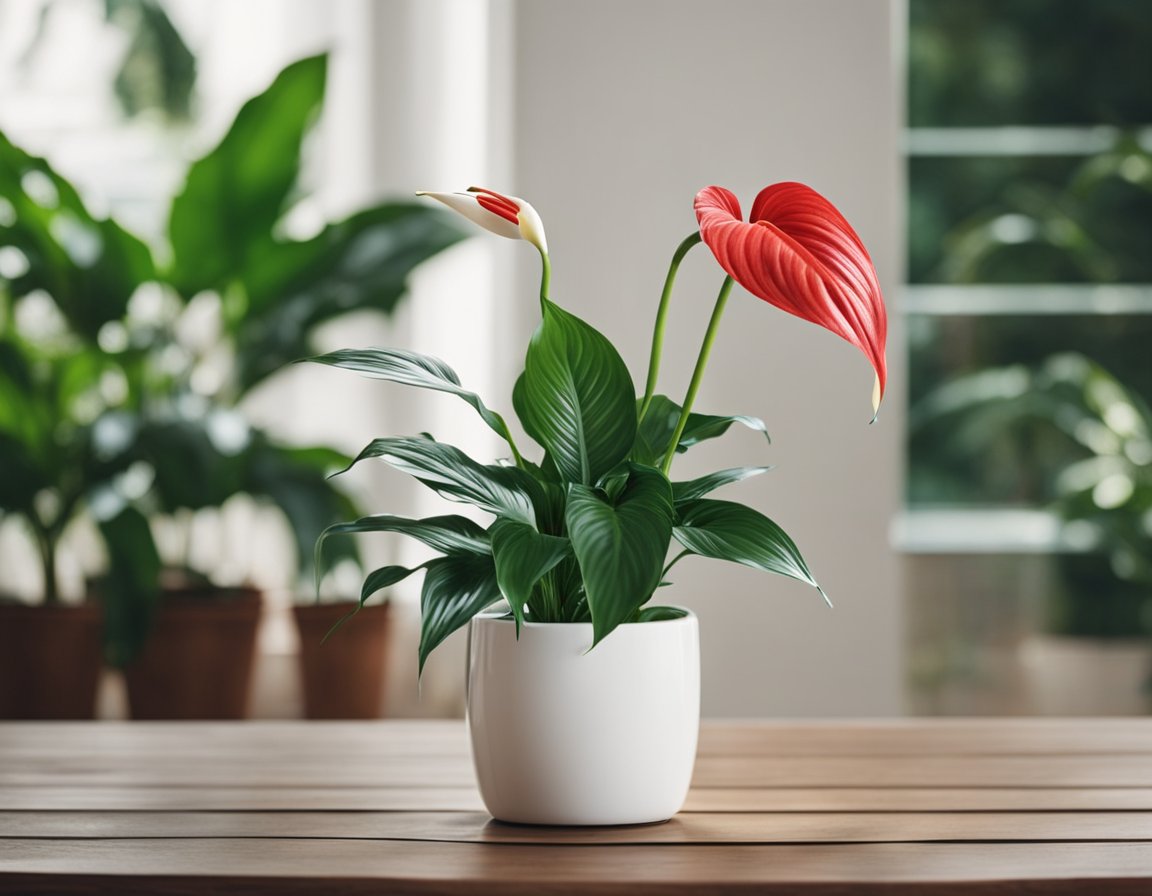Is Red Peace Lily Toxic to Cats? Here’s What You Need to Know
If you’re a cat owner, you’re likely aware of the dangers of toxic plants. One plant that has been a topic of concern for cat owners is the Red Peace Lily.
While Peace Lilies are known to be toxic to cats, the question remains whether the Red Peace Lily is equally dangerous.

Red Peace Lilies are a popular houseplant due to their striking red flowers and easy care. However, if you have a cat, you may want to think twice before bringing one of these plants into your home. The Red Peace Lily may contain calcium oxalate crystals that can cause oral irritation, intense burning, and irritation of the mouth, tongue, and lips, excessive drooling, vomiting, and difficulty swallowing in cats if ingested.
If you’re worried about the safety of your cat around Red Peace Lilies, it’s important to know the effects of this plant on cats and how to prevent your cat from being exposed to it. In this article, we’ll discuss the potential dangers of Red Peace Lilies to cats, what to do if your cat ingests this plant, and how to keep your cat safe from toxic plants.
Key Takeaways
- Red Peace Lilies may contain calcium oxalate crystals that can cause oral irritation, intense burning, and irritation of the mouth, tongue, and lips, excessive drooling, vomiting, and difficulty swallowing in cats if ingested.
- To prevent cat exposure to Red Peace Lilies, keep the plant out of reach, consider alternative non-toxic plants, and supervise your cat when they are around plants.
- If your cat ingests Red Peace Lily, seek veterinary attention immediately.
Is Red Peace Lily Toxic to Cats

If you’re a cat owner and you’re considering getting a Red Peace Lily, you may be wondering whether it’s safe for your furry friend. Unfortunately, the answer is no. Like other types of Peace Lilies, Red Peace Lilies are toxic to cats.
Red Peace Lilies contain insoluble calcium oxalates, which can cause oral irritation, intense burning, and irritation of the mouth, tongue, and lips in cats. If your cat ingests any part of the Red Peace Lily, they may experience excessive drooling, vomiting, and difficulty swallowing.
It’s important to note that the severity of the symptoms can vary depending on the amount of Red Peace Lily ingested and the size of your cat. However, it’s always better to err on the side of caution and keep Red Peace Lilies out of reach of your pets.
If you suspect that your cat has ingested any part of a Red Peace Lily, it’s important to contact your veterinarian immediately. They may recommend inducing vomiting or administering activated charcoal to prevent the absorption of the toxins.
Overall, while Red Peace Lilies may be a beautiful addition to your home décor, they are not worth the risk to your furry friend’s health. If you’re looking for pet-friendly plants, there are many non-toxic options available, such as spider plants, Boston ferns, and African violets.
Effects of Red Peace Lily on Cats

If you are a cat owner, you might be wondering whether red peace lilies are toxic to your furry friend. The answer is yes, red peace lilies are toxic to cats. They contain insoluble calcium oxalate crystals that can cause a range of symptoms in cats, from oral irritation to kidney failure.
Immediate Effects
If your cat ingests a red peace lily, they may experience immediate symptoms such as:
- Drooling
- Vomiting
- Diarrhea
- Difficulty swallowing
- Oral irritation
- Pawing at the mouth or face
These symptoms can be very uncomfortable for your cat and can last for several hours. If your cat is experiencing any of these symptoms, it is important to seek veterinary care immediately.
Long Term Effects
If your cat ingests a large amount of a red peace lily or if they are not treated promptly, they may experience long term effects such as:
- Kidney damage
- Kidney failure
- Death
It is important to note that even small amounts of a red peace lily can be toxic to cats, so it is important to keep these plants out of reach of your furry friends.
In conclusion, if you are a cat owner, it is important to be aware of the potential dangers of red peace lilies. If you suspect that your cat has ingested a red peace lily, seek veterinary care immediately.
Preventing Cat Exposure to Red Peace Lily

If you have a red peace lily and a cat, it is important to take steps to prevent your cat from being exposed to the plant. Here are some tips to help you create a safe environment for your furry friend.
Creating a Safe Environment
The first step in preventing cat exposure to red peace lily is to keep the plant out of reach. Cats are curious creatures and may be tempted to chew on the leaves or flowers of the plant. Place the plant in a location that is inaccessible to your cat, such as a high shelf or a room that is off-limits to your pet.
If you have a particularly curious cat, you may need to take additional measures to keep them away from the plant. You can use a physical barrier, such as a plant stand or a piece of furniture, to block access to the plant. You can also use a pet deterrent spray to discourage your cat from going near the plant.
Alternative Plants for Cats
If you are concerned about the potential toxicity of red peace lily, there are many alternative plants that are safe for cats. Here are some options to consider:
- Spider plant: This plant is non-toxic to cats and is easy to care for.
- Boston fern: This plant is safe for cats and can help purify the air in your home.
- African violet: This plant is safe for cats and adds a pop of color to your home.
When choosing plants for your home, be sure to research their toxicity to cats. If you are unsure about the safety of a particular plant, consult with your veterinarian.
By taking steps to prevent cat exposure to red peace lily and choosing safe alternative plants, you can create a happy and healthy environment for both you and your furry friend.
What to Do If Your Cat Ingests Red Peace Lily
If you suspect that your cat has ingested any part of a red peace lily, it is important to act quickly. Here are some immediate steps you can take:
Immediate Steps
- Remove any remaining plant material from your cat’s mouth. If your cat has any pieces of the plant in their mouth, gently remove them to prevent further ingestion.
- Wash your cat’s mouth and paws with water. Use a wet cloth or paper towel to gently wipe your cat’s mouth and paws, removing any remaining plant material.
- Monitor your cat’s behavior. Keep a close eye on your cat for any signs of distress, such as vomiting or diarrhea.
When to Contact a Veterinarian
If you notice any of the following symptoms, contact your veterinarian immediately:
- Vomiting
- Diarrhea
- Lethargy
- Loss of appetite
- Drooling
- Difficulty breathing
When you speak to your veterinarian, be sure to mention that your cat has ingested a red peace lily. This will help your veterinarian provide the appropriate treatment for your cat.
It is important to act quickly if you suspect that your cat has ingested any part of a red peace lily. With prompt action and proper treatment, your cat can make a full recovery.
Are Other Types of Peace Lilies Toxic to Cats?
While red peace lilies are the most dangerous type of peace lily for cats, other varieties can also be toxic. This includes the common peace lily, which is a popular houseplant known for its attractive foliage and white flowers.
The good news is that there are plenty of non-toxic houseplants that you can choose from if you’re a cat owner. Some options include spider plants, Boston ferns, and African violets. Just be sure to do your research and check the toxicity of any plant before bringing it into your home.
Alternatives to Red Peace Lilies for Cat Owners
If you’re a cat owner looking for non-toxic houseplants, there are plenty of options to choose from. Here are a few ideas:
- Spider plants: These plants are easy to care for and have long, narrow leaves that are safe for cats to nibble on.
- Boston ferns: These ferns have soft, feathery fronds that cats love to play with. They’re also great at purifying the air in your home.
- African violets: These flowering plants come in a variety of colors and are safe for cats to be around.
- Bamboo palm: This plant has a tropical look and is safe for cats to be around. It’s also great at removing toxins from the air.
Frequently Asked Questions (FAQs)
Can red peace lilies kill cats?
While it’s rare for red peace lilies to be fatal to cats, they can cause serious health problems if ingested. It’s important to seek veterinary care if you suspect that your cat has eaten red peace lilies.
What are the signs of red peace lily poisoning in cats?
Symptoms of red peace lily poisoning in cats can include drooling, pawing at the mouth, vomiting, and diarrhea. In more severe cases, cats may have difficulty breathing or become lethargic.
Conclusion
In conclusion, red peace lilies are beautiful plants that can brighten up any home, but they’re also toxic to cats (and other pets and humans). As a pet owner, it’s important to be aware of the potential dangers and take steps to keep your furry friends safe.
If you do choose to keep red peace lilies, be sure to handle them carefully and keep them out of reach of your cat. And if you’re looking for non-toxic houseplants, there are plenty of great options out there that your cat will love just as much. Stay safe and happy planting!






